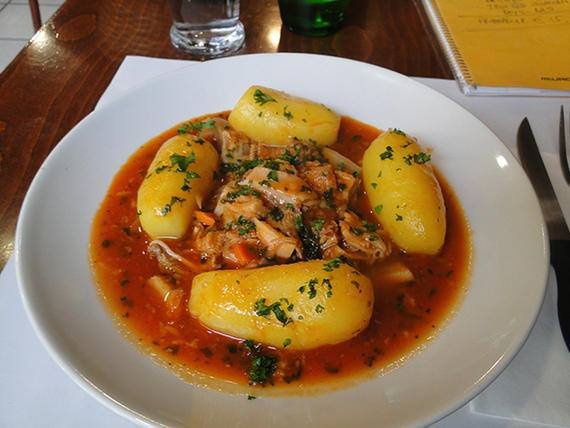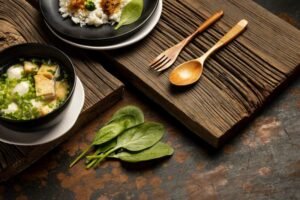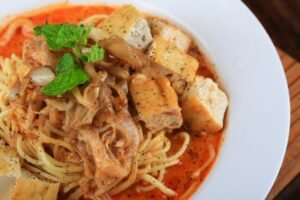In the culinary sphere, offal dishes have long occupied a unique and often underappreciated niche, offering a taste of history and tradition through their use of every part of the animal. Among these dishes is Kuddelfleck, a lesser-known delicacy that deserves attention for its robust flavors and cultural significance. Originating from regions where resourcefulness in cooking was paramount, Kuddelfleck is made from tripe, a part of the cow’s stomach, and it is often prepared with a medley of vegetables and spices, resulting in a dish that is both hearty and nuanced.
Luxembourg provides a fascinating backdrop for exploring offal cuisine, where historic practices of utilizing all parts of the animal are still evident in modern dining. Other offal dishes include traipen, a traditional black pudding crafted with pork blood, oats, and spices, and leberkniddelen, which are savory liver dumplings. These dishes not only reflect Luxembourg’s culinary heritage but also embody a sustainable approach to cooking that minimizes waste and maximizes flavor.
For adventurous eaters and those interested in expanding their culinary horizons, offal dishes like Kuddelfleck offer a rich exploration of flavor profiles that are rarely found in mainstream cuisine. The preparation of such dishes often involves techniques that have been passed down through generations, preserving a connection to the past while offering a unique dining experience. As more chefs and home cooks alike seek to diversify their menus with bold and authentic flavors, Kuddelfleck and its counterparts stand out as prime examples of how traditional ingredients can be reimagined for contemporary palates.
What is Kuddelfleck and Other Offal Dishes?
Kuddelfleck, a dish hailing from Luxembourg, offers a unique glimpse into the country’s culinary tradition of utilizing every part of the animal. This dish, essentially a tripe stew, is typically enriched with a robust sauce that might include ingredients like onions, carrots, and a variety of spices. The preparation of Kuddelfleck is an art form, requiring both time and skill to transform the humble tripe into a flavorful and aromatic dish that resonates with the essence of Luxembourg’s gastronomic history.
These dishes are more than just sustenance; they are a reflection of Luxembourg’s historic use of all parts of the animal. This practice, born out of necessity, has evolved into a cherished aspect of culinary heritage, showcasing creativity and resourcefulness. Offal dishes are celebrated for their rich flavors and textures, offering a dining experience that is both rustic and sophisticated.
In addition to Kuddelfleck, other offal dishes popular in Luxembourg include Traipen and Leberkniddelen. Traipen, a type of black pudding, is crafted using pork blood, oats, and a mixture of spices. This dish is known for its dense, hearty texture and deep, savory flavor profile, making it a staple in traditional Luxembourgish meals. Meanwhile, Leberkniddelen, or liver dumplings, are another testament to the innovative use of offal, combining liver with breadcrumbs and herbs to create a dish that is both nutritious and satisfying.
Luxembourg’s offal dishes, including Kuddelfleck, Traipen, and Leberkniddelen, stand as a testament to the country’s culinary ingenuity. These dishes not only provide a taste of the past but also continue to be a beloved part of modern Luxembourgish cuisine, inviting adventurous eaters to explore the rich, diverse flavors that offal can offer.
Exploring the Culinary History and Origins of Kuddelfleck
The dish known as Kuddelfleck holds a significant place in the rich tapestry of European culinary traditions, particularly within the German-speaking regions. Its roots can be traced back to a time when resourcefulness in the kitchen was not merely a preference but a necessity. Offal, or the internal organs and entrails of butchered animals, was a staple in many households, and Kuddelfleck, with its main ingredient of tripe, exemplifies this tradition.
Tripe, the lining of the cow’s stomach, has been utilized in various forms across cultures due to its affordability and nutritional value. In Kuddelfleck, the tripe is meticulously cleaned, boiled, breaded, and then fried to a crunchy perfection, often accompanied by a delicate white wine sauce that enhances its earthy flavors. This dish not only highlights the ingenuity of past generations in utilizing every part of the animal but also showcases an aspect of culinary heritage that persists in modern times.
The Cultural Context of Offal Dishes
Across Europe, offal dishes have been a testament to culinary creativity and survival, with each region boasting its own unique variations. In Germany and surrounding areas, tripe dishes found their place on the tables of both the working class and the affluent, albeit with variations in preparation and presentation. Other offal dishes include Traipen, a black pudding made with pork blood, oats, and spices, and Leberkniddelen, known as liver dumplings, which emphasize the versatility and resourcefulness characteristic of traditional European cuisine.
These dishes not only provided nourishment but also played a role in community and family gatherings. The process of preparing such meals was often communal, with recipes and techniques passed down through generations, preserving not just the flavors but also the stories and traditions associated with them.
Embracing Tradition in Contemporary Cuisine
Today, Kuddelfleck and other offal dishes are enjoying a resurgence as chefs and home cooks alike rediscover the value and depth of flavor they offer. While some modern adaptations may incorporate new ingredients or techniques, the essence of these dishes remains rooted in their historical origins. The renewed interest in such traditional fare is a celebration of culinary history, inviting a new generation to appreciate the complexity and richness of flavors that offal dishes bring to the table.
- Traipen: A hearty black pudding, integral to the culinary practices of the region.
- Leberkniddelen: Liver dumplings that highlight the use of organ meats in traditional dishes.
- Kuddelfleck: Breaded and fried tripe, offering a glimpse into the resourcefulness of past generations.
As the culinary world continues to evolve, the exploration and appreciation of dishes like Kuddelfleck serve as a reminder of the enduring legacy of traditional cooking practices. These dishes not only nourish the body but also forge a connection to the past, honoring the skills and creativity of those who came before.
How to Prepare and Enjoy Kuddelfleck at Home
When exploring the realm of offal dishes, kuddelfleck stands out as a distinctive culinary experience. This dish, which consists of breaded and fried tripe often served with a white wine sauce, offers a unique opportunity to explore the textures and flavors that organ meats can bring to the table. While other offal dishes include traipen, a black pudding made with pork blood, oats, and spices, and leberkniddelen, liver dumplings, kuddelfleck provides a different approach to preparing tripe.
Ingredients and Preparation
The first step in preparing kuddelfleck is to source high-quality tripe. Tripe can be found at most well-stocked butcher shops or specialty markets. Once you have your tripe, it needs to be thoroughly cleaned and parboiled to ensure the best texture and flavor. After parboiling, cut the tripe into manageable pieces, typically small strips, to facilitate even cooking and breading.
For the breading, a mixture of breadcrumbs, flour, and seasonings like salt, pepper, and paprika works well. Dredge the tripe pieces in the mixture, ensuring a light yet even coating. Fry the breaded tripe in a neutral oil until it reaches a golden brown, crispy finish. This process not only enhances the texture but also complements the mild flavor of the tripe.
Serving Suggestions
To elevate the dish, prepare a white wine sauce that can be drizzled over the fried tripe. This sauce typically involves reducing white wine with a bit of butter, garlic, and herbs such as thyme or parsley, creating a balance of acidity and richness that pairs beautifully with the crispy tripe. For an added layer of flavor, consider incorporating a splash of lemon juice or a hint of mustard to the sauce.
Serve kuddelfleck with a side of fresh, crusty bread and a simple salad of bitter greens like arugula or frisee, which can cut through the richness of the dish. A well-chilled glass of the same white wine used in the sauce will complement the meal perfectly, rounding out the flavors and providing a harmonious dining experience.
By following these detailed steps, you can create a memorable kuddelfleck dish at home, showcasing the versatility and depth of flavor that offal dishes can offer.
Discovering Offal Dishes from Around the World and Their Unique Flavors
Offal dishes, often misunderstood, offer a world of flavor and historical significance. These dishes, crafted from the organs and entrails of animals, have been cherished in various cultures for their rich tastes and nutritional value. Among these, kuddelfleck stands out as a specialty from Germany, where breaded fried tripe is often served with a delicate white wine sauce. This dish highlights how offal can be transformed into a gourmet experience, combining unexpected textures with refined sauces.
In Belgium, one can discover the savory delight of traipen, a type of black pudding. This dish, made with pork blood, oats, and spices, offers a robust flavor profile that is cherished in local cuisine. Its preparation reflects the ingenuity in using every part of the animal, resulting in a dish that is both hearty and flavorful.
Traveling to Luxembourg, the culinary journey continues with leberkniddelen, or liver dumplings. These dumplings are crafted from finely chopped liver, bread, and spices, and are often served in a broth or with a creamy sauce. The dish is a testament to the rich culinary traditions that embrace offal as a staple ingredient, providing a depth of flavor that is both unique and satisfying.
Offal dishes are as diverse as the cultures they come from. Each dish brings with it a story of tradition, sustainability, and culinary creativity. These dishes challenge our perceptions and invite us to appreciate the full spectrum of flavors and textures that offal can offer. Whether it’s the crispy, delicate nature of kuddelfleck, the spicy richness of traipen, or the comforting warmth of leberkniddelen, offal dishes continue to offer a culinary adventure for those willing to explore beyond the conventional.










